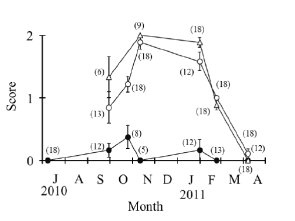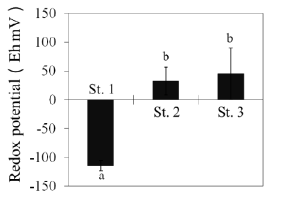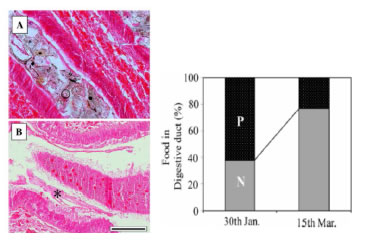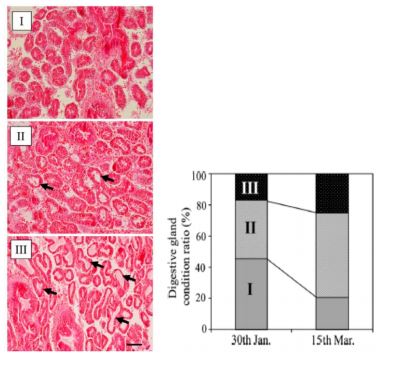Disincentive factors affecting stable aquaculture production of the blood cockle, Anadara granosa, in Malaysia
Description
The blood cockle, Anadara granosa, is an important bivalve aquaculture species in Southeast Asian countries. They thrive where there is a widespread presence of mud flats, as in the west coast of Peninsular Malaysia, which provide suitable habitat and is a center for sowing aquaculture. Blood cockle spats are naturally abundant along the coasts and are exported to neighboring countries as aquaculture seeds. Recently, however, a huge reduction in the number of spats in aquaculture grounds in the west coast has been noted. Likewise, the farming process has been seriously affected by mass mortality. Therefore, some of the possible causes were investigated and countermeasures were formulated. In this study, we revealed the disincentive factors affecting blood cockle aquaculture and considered future measures for achieving stable production.
Regular monitoring was carried out in three sampling stations in blood cockle aquaculture grounds. Results showed failure of sexual maturation in Station 1 during the monitoring period (Fig. 1). In addition, surface sediments in Station 1 had been significantly reduced, according to an environmental survey carried out in November 2010 (Fig. 2). High organic loading in the aquaculture grounds was suggested as one failure factor for the phenomena. On the other hand, a case study of the mass mortality event in mid-February 2012 (more than 30% mortality in Selangor coast) revealed that the blood cockle was in its spawning season and that it was in failure condition due to reduced food availability, based on histological observations of the gonad and digestive ducts, respectively (Fig. 3). Moreover, these results suggested that the cockles failed to absorb nutrients as evidenced by the flattening of epithelial cells in their digestive glands (Fig. 4). Incidentally, mass mortality occurred during a week-long rainy period (over 30 mm/day for four days). Environmental changes associated with freshwater inflow, carrying with it high-suspended matter from rivers, may have weakened the blood cockle’s environmental resistance especially because they were spawning. Thus, it was inferred that reduced feeding opportunities and nutrient absorption disorders may have led to the blood cockle’s debilitated condition.
For a sustainable blood cockle aquaculture, it is important to lower the mortality rate in the aquaculture process and produce a stable supply of blood cockle spats. In the future, we need to establish water and sediment quality standards in aquaculture grounds as a fisheries management strategy and connect sound management approaches to stable production, with the Malaysian local government and fishermen playing leading roles in managing water and sediment quality. We intend to recommend this system to the Department of Fisheries in Malaysia for implementation and realization in the near future.
Figure, table
-
Fig. 1. Naked-eye observations of the visceral area covering the gonad of the blood cockle.
Score 0: immature, score 1: developing, and score 2: mature. Number in parentheses refers to the number of individuals used for observation. The graph shows that there was no gonad development at Station 1 (●), whereas significant development was observed at Stations 2 and 3 (○ and △). Error bar indicates standard error. -
Fig. 2. Redox potentials in surface sediments around the blood cockle aquaculture grounds.
Significant reduction was detected at Station 1 where sexual maturation of the blood cockle was not observed. Significant difference (P <0.01) was observed between a and b. This survey was conducted in November 2010 when gonad development was observed in Stations 2 and 3. Error bar indicates standard error. -
Fig. 3. Presence and nonpresence of food in the digestive duct of the blood cockle before and after the mass mortality event.
Photo A: digestive duct filled with food, Photo B: no food in the duct (asterisk shows the empty digestive duct.) Scale bar in photo: 100 μm. Graph data shows an increase in the number of individuals with empty digestive ducts after the mass mortality event. -
Fig. 4. Condition of epithelial cells in the digestive gland of the blood cockle before and after the mass mortality event.
Photo I: good condition of epithelial cells, photo II: partial flattening of epithelial cells (arrows), photo III: substantial flattening of epithelial cells (arrows). Scale bar in photo: 100 μm. Graph data shows an increase in the number of individuals with flattened epithelial cells after the mass mortality event.
- Affiliation
-
Japan International Research Center for Agricultural Sciences Fisheries Division
- Classification
-
Administration B
- Research project
- Program name
- Term of research
-
FY 2014 (FY 2011-FY 2015)
- Responsible researcher
-
Yurimoto Tatsuya ( Fisheries Division )
Kassim Faizul Mohd ( Fisheries Research Institute, Malaysia )
Fuseya Reiko ( National Research Institute of Fisheries Engineering, FRA )
KAKEN Researcher No.: 40373469Man Alias Bin ( Fisheries Research Institute, Malaysia )
- ほか
- Publication, etc.
-
Yurimoto et al. (2014) International Journal of Aquatic Biology, 2(3):115-123.
https://doi.org/10.1007/s40071-014-0077-3Yurimoto et al. (2014) International Aquatic Research
- Japanese PDF
-
2014_C09_A3_ja.pdf272.76 KB
2014_C09_A4_ja.pdf271.08 KB
- English PDF
-
2014_C09_A3_en.pdf251.91 KB
2014_C09_A4_en.pdf337.39 KB
- Poster PDF
-
2014_C09_poster.pdf332.08 KB




